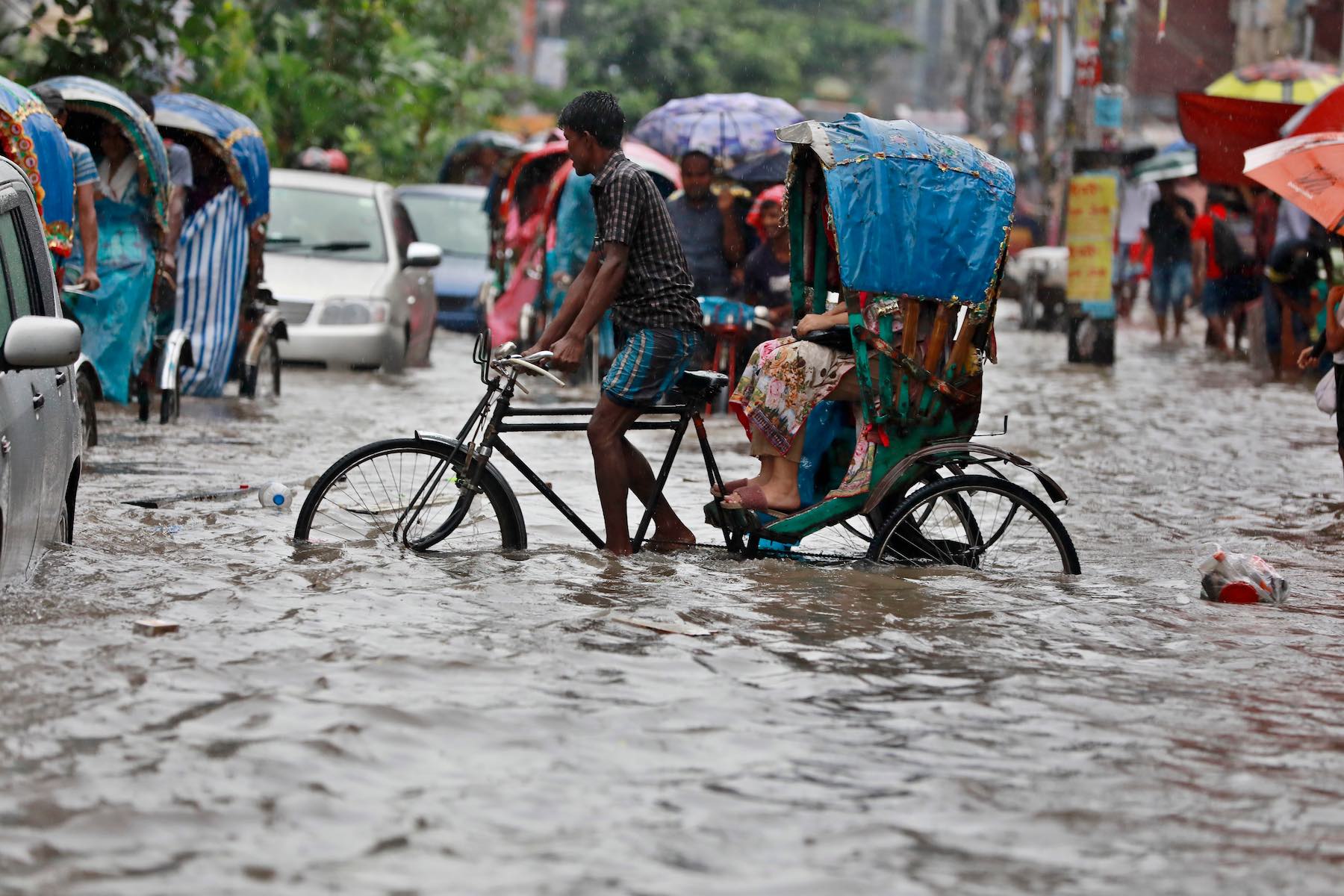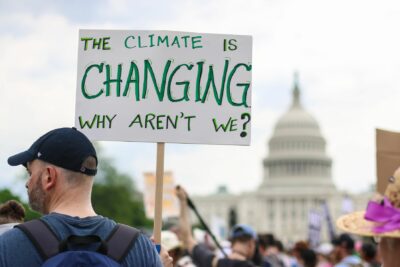The climate crisis is one of the most pressing issues facing humanity today. Climate change is caused by the buildup of greenhouse gasses, such as carbon dioxide and methane, in the atmosphere. These gasses trap heat from the sun and warm the planet, leading to a range of environmental and social impacts. The main issue facing humanity in terms of global warming is the massive increase of anthropogenic [human-caused] greenhouse gasses. Human activity has had, and will continue to have, a massive impact on the global climate, with inescapable consequences.
The Science of Climate Change
The Intergovernmental Panel on Climate Change (IPCC) released its sixth assessment report in early 2023. We’re not going to lie to you: it’s looking bad. The very first sentence in the summary for policy-makers, outlined in red is:
“Human activities, principally through emissions of greenhouse gasses, have unequivocally caused global warming, with global surface temperature reaching 1.1°C above 1850–1900 in 2011–2020. Global greenhouse gas emissions have continued to increase, with unequal historical and ongoing contributions arising from unsustainable energy use, land use and land-use change, lifestyles and patterns of consumption and production across regions, between and within countries, and among individuals.”
The report goes on to explain that the global surface temperature is on average almost 1.1 degrees higher, but almost 1.6 degrees higher over land. The global surface temperature has increased faster since 1970 than any other period in the last 2000 years. Average greenhouse gas emissions between 2010 and 2019 were higher than any other recorded years, and the concentrations of CO2, methane and nitrous oxide are higher than at any time in the last 1-2 million years.
What Does Climate Change Mean for People?
According to the IPP report, the most serious of the impacts is this:
“Widespread and rapid changes in the atmosphere, ocean, cryosphere and biosphere have occurred. Human-caused climate change is already affecting many weather and climate extremes in every region across the globe. This has led to widespread adverse impacts and related losses and damages to nature and people. Vulnerable communities who have historically contributed the least to current climate change are disproportionately affected.”
As many of us already know, then, it is principally the responsibility of the developed world that we are now facing this unavoidable and collective crisis of literally global proportions.
Blah Blah Blah
Perhaps most alarming is that despite all the back-patting and self proclaimed “efforts” seen in the press from politicians and large corporations, the report goes on to state that:
“Current global financial flows for adaptation are insufficient for, and constrain implementation of, adaptation options, especially in developing countries.“
In short, the global north is not doing enough, and is even hampering the work that would help those most vulnerable to climate breakdown to survive.
The Earth’s average temperature has already increased by about 1 degree Celsius since pre-industrial times, and is projected to increase by another 1.5 degrees by the end of the century if emissions are not dramatically reduced. This leaves the Paris Agreement of limiting “the increase in the global average temperature to well below 2°C above pre-industrial levels” and “to limit the temperature increase to 1.5°C above pre-industrial levels”, which came into force in 2016, looking increasingly like wishful thinking.
What Will Climate Change Do?

This increase in temperature is causing more frequent and intense heat waves, droughts, wildfires, and storms, which in turn have devastating impacts on ecosystems and human communities. Climatic and non-climatic disasters will increase as they interact and their effects are compounded. These new multi-factorial risks and disasters will become ever more complex and expensive to mitigate and manage.
Another major impact of the climate crisis is sea level rise. As the planet warms, ice sheets and glaciers are melting, causing sea levels to rise. This is already leading to flooding and erosion in many coastal communities, and is expected to displace millions of people in the coming decades. Communities such as those in the Netherlands or in London, UK are able to divert billions into complex, technical and engineering-based solutions like the Thames barrier, but smaller, developing communities will simply be displaced or erased. In many cases, these changes will not simply be temporary; they will be irreversible.
Communities Will Be Lost

Most at risk are small, low-lying island nations like Tuvalu, an island chain in the Pacific halfway between Hawaii and Australia. The highest points of the island are about 4-5m above sea level. With sea level rise, the islands flood more and more often, and damage becomes more severe. Soon these people will be stateless and homeless.
The climate crisis also has significant impacts on biodiversity. As temperatures and weather patterns change, species are being forced to adapt or move to new habitats. Many species are already struggling to keep up with the pace of change, and are at risk of extinction. Already, human activity has precipitated a mass extinction event, with 70 percent of animal populations disappearing just since 1970.
Mitigating the Climate Crisis
To address the climate crisis, urgent action is needed to reduce greenhouse gas emissions. This will require transitioning to cleaner forms of energy, such as wind and solar power, and reducing our dependence on fossil fuels. As the IPCC explains, to limit human-caused global warming would require net zero CO2 emissions. We will also need to adapt to the changes that are already underway, such as by building resilient infrastructure and protecting vulnerable communities.
It is no longer enough, either, for richer, so-called developed nations to buy carbon credits from nations with less developed industrial infrastructure, allowing them to spew out a larger quota of greenhouse gasses with no accountability other than shifting money around the globe. Governments must tighten rules and regulations and make sure they are followed. Schemes to ‘offset’ carbon footprints would be scrutinized more closely to make sure they are not using loopholes such as investing in ‘potential carbon offsetting’ in projects that aren’t even being implemented yet.
In the meantime, we as individuals can also accept some responsibility, we can play our part to contribute as little as possible to global warming. And we can keep the pressure on bigger companies who must start to take heed and change too, and faster. Nevertheless, the responsibility we have, us as individuals and them as big corporations, isn’t the same. But we have to try, right?
What Can We Do To Help Reduce Climate Change?
So, what’s the easiest and most effective way to fight climate change on an individual scale? Take more trains? Stop flying? Recycle everything you use? In fact, the answer is much more effective… change your diet.
The production of meat, especially beef, requires a huge amount of natural resources, including land, water, and energy often acquired through the use of fossil fuels. Human consumption of animal products accounts for 16.5 percent of all anthropogenic greenhouse gas emissions. This is a staggering figure, but it is easier to understand if you take into account that there is a whole supply chain associated with the production of this food. There is land clearance and deforestation for grazing and to grow crops to feed billions of farmed animals, storage, manure processing, transport of live animals and animal products, refrigeration and packaging. And it’s not just meat; milk also has a huge impact on greenhouse gas emissions.
Cut Out Meat To Save the Planet

As a food source for humans, meat is incredibly inefficient. In terms of land use, Oxford university researchers explain that it uses 83 percent of agricultural land globally, while providing only 18 percent of the calories we consume. An astonishing 86 percent of all land mammals are now farmed creatures intended for human consumption with the global north consuming far more meat than the south, despite having a far smaller population. For example, in the US, the average consumer can get through over 100kg of meat a year, while in places like Nigeria or India, it may barely reach 10kg.
So, in the global north we have more responsibility, but we also have more opportunity. Cutting down on animal products in our diets is the single greatest, and possibly easiest, method to make a direct impact on your carbon footprint and as a result help to reduce global carbon emissions.
Five Easy Diet Changes to Save the Planet
There are loads of little actions you can take to decrease your animal product consumption, and they’re so easy you’ll barely notice.

1. Swap Your Milk!
Changing our milk is a really easy way to get started on your journey towards reducing the size of your carbon footprint. Plant-based milks have been around for so long that there are so many varieties and options, rather than just one for dairy. Soy is a great option, and so are oat, rice, hemp, cashew, and hazelnut. However, lots of people stay away from almond milk because the methods for farming almonds sometimes require a huge sacrifice for bee populations. In commercial almond production, bees are woken early from hibernation each year and sent to work in pesticide-heavy environments from which millions do not return.
2. Substitute One Thing at a Time
In some meals you can simply take out a meat ingredient, and pop in a plant-based version instead. You won’t even need to change the cooking method. For example, a bolognese with beef or lamb mince can easily be a bolognese with lentils, beans, or textured soy or pea protein. With the plant-based boom, you can also find a DopSu – a doppelganger substitute – and go for a plant-based mince. Easy peasy. The world is your oyster, your vegan oyster, that is.
3. Go Back to School!
It can feel daunting learning how to cook with ingredients you have never used before, especially if your favorite meals are the ready-to-go ones. Suddenly, tofu, seitan, or tempeh can seem challenging because they don’t behave like meat. We live in the digital age, though, and there are millions of plant-based recipes online that can teach you how to make anything from a plant-based scone, to vegan duck a l’orange. Check out some of our favorite easy recipes for you to start with.
4. It’s Not Just Meat
Remember that fish make up a huge part of animal agriculture, so much so that they are measured in tonnes, rather than individuals consumed. There are loads of plant-based fish alternatives appearing on the market now, or you can even make them yourself by simply smashing up some chickpeas with a bit of olive oil and some shredded seaweed. You’ll be surprised how fishy a chickpea can taste.
5. Come Out of the Vegan Closet
Try eating plant-based when you go out to eat. More and more restaurants are adding plant-based options to their menus, and they’re pretty much guaranteed to be delicious. If you’re unsure where your best local vegan meals can be found, try the HappyCow app.
The number 1 reason for people to go back eating animals is peer pressure, so take your time, don’t worry about striving for perfection, just make some simple changes and help protect our planet.
Interested in trying vegan with us for one week to protect the planet? Try our fun and free 7-Days Vegan challenge.



